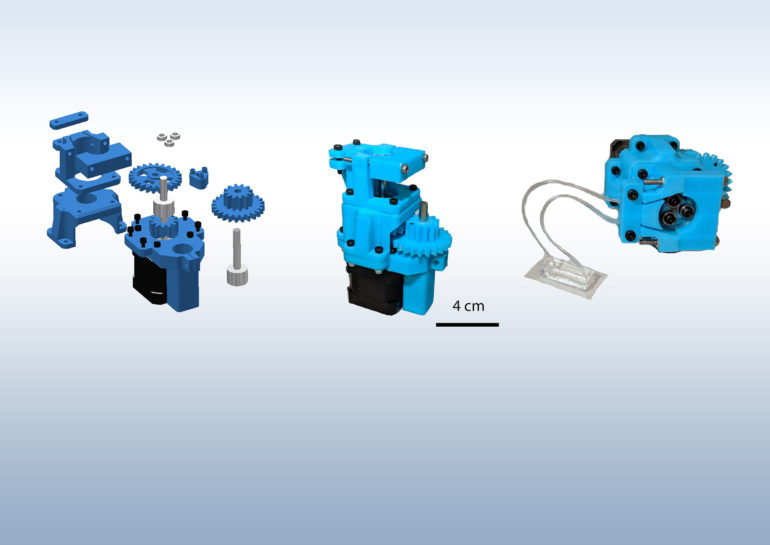A student’s side project created to optimize his lab work has piqued the interest of the global scientific community, putting it in the top 10 chemistry papers published in Scientific Reports in 2020.
Michael Behrens’ synthetic biology research at the University of Pittsburgh requires the use of microfluidic devices, which allow researchers to rapidly perform biology or chemistry experiments on a small scale.
Doing this work on a small scale helps save time and precious research dollars by allowing investigators to stretch resources, but Behrens saw more room for improvement. The peripheral equipment often required for microfluidic experiments adds to the cost and complexity, so he decided to innovate a solution to this problem.
Behrens’ open-source, 3D-printed tool is not only cheaper, but it also adds a level of flexibility for tech-savvy researchers to fully harness these transformative devices.
“Peristaltic pumps for microfluidic devices already exist, but I wanted a simple, reliable version that could carry small volumes of liquid,” said Behrens, a bioengineering Ph.D. student at Pitt’s Swanson School of Engineering. “It’s cheaper to build it yourself, but we also added a level of flexibility by incorporating programmable microcontrollers that allow for custom flow profiles.”
Microfluidic devices have a wide range of applications, including point-of-care diagnostics—much like the testing we have witnessed for the COVID-19 pandemic. This type of technology, also known as lab-on-a-chip, can quickly deliver much needed results and has transformed testing—particularly in times of emergency, at-home care, or in places that lack clinical infrastructure.
“Since our pump is relatively cheap and easy to build and use, it could enable places with resource constraints to still have advanced diagnostics,” he said. “This pump could allow clinicians to run reagents past cells grown in a microfluidic device and do quick on-site testing, or allow high school labs to experiment with modern chemistry and biology research techniques.”
For Behrens, the tool has helped advance his biorobotics research in the Synthetic Biology and Biomimetics Lab led by Warren Ruder, associate professor and William Kepler Whiteford Faculty Fellow of Bioengineering at Pitt. He believes this tool could help fellow engineers stretch their budgets and more effectively utilize microfluidic technologies.
“I think there an unmet need to develop cheap tools to make microfluidics more accessible, especially for researchers,” he said. “The success of the paper shows me that a lot of people are interested in microfluidics, and providing open-source tools to help enable those technologies seems like a useful thing to do.”
Pioneering technique paves way for fast and cheap fabrication of rapid medical diagnostic tools
More information:
Michael R. Behrens et al. Open-source, 3D-printed Peristaltic Pumps for Small Volume Point-of-Care Liquid Handling, Scientific Reports (2020). DOI: 10.1038/s41598-020-58246-6
Provided by
University of Pittsburgh
Citation:
DIY microfluidic tool climbs to the top of the charts (2021, April 6)
retrieved 11 April 2021
from https://techxplore.com/news/2021-04-diy-microfluidic-tool-climbs.html
This document is subject to copyright. Apart from any fair dealing for the purpose of private study or research, no
part may be reproduced without the written permission. The content is provided for information purposes only.



